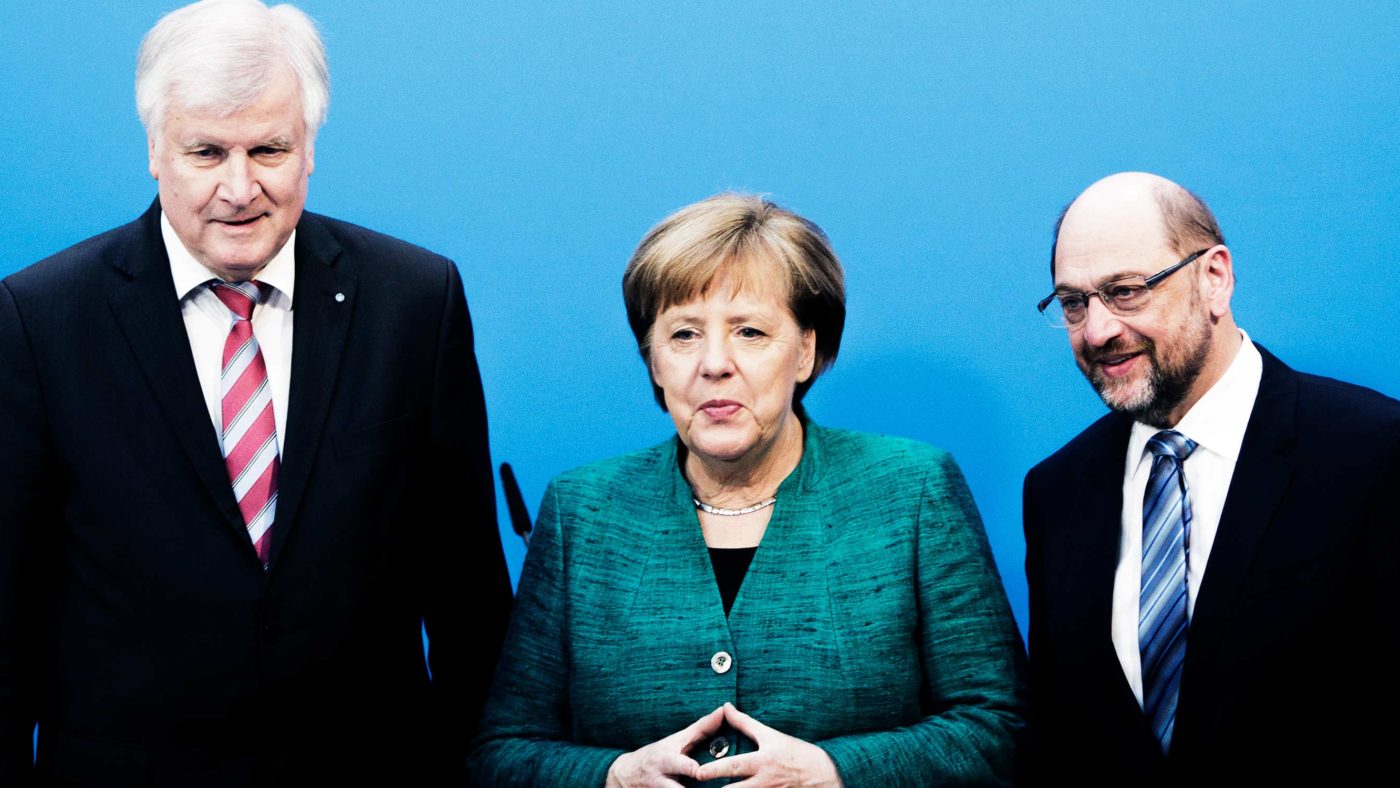More than four months after Germany’s federal elections in September 2017, the country finally has a new government. Although it’s not that new. This morning, Chancellor Angela Merkel’s conservative bloc – the Christian Democrats (CDU) and Bavarian Christian Social Union (CSU) – at last concluded coalition talks with the Social Democrats (SPD), meaning Germany will be governed by the same grand coalition that has been in charge since 2013.
Technically, there remains another hurdle to clear, with the SPD putting the deal to a vote by its membership. But that shouldn’t be a problem. Most Germans will welcome the clarity about a new government, putting an end to the political debates that went on for months. Few, however, will be pleased that it is this government. Recent polls suggest that just 45 per cent of Germans are positive about a new “grand coalition”. Earlier in January, a majority of SPD supporters opposed the arrangement.
That is understandable. Grand coalitions are supposed to be an exception, providing temporary stability in times of crisis. At the end of this new government’s four-year term however, in 2021, Germany will have been governed by a grand coalition for a total 12 out of the last 16 years.
With a CDU that under Merkel continuously moved to the left, and an SPD that never credibly reversed its Blairite turn in the early 2000s, Germany seems stuck with a coalition that embodies a big, muddled, centrist compromise – a coalition that shows neither the desire nor the ability to tackle the country’s fundamental challenges.
Public discontent with the last grand coalition showed itself in the 2017 elections. The governing parties’ vote share dropped by 13.8 per cent compared to 2013. And so even though the grand coalition is poised to govern once more, its power is severely diminished. Where it held 80 per cent of seats in the Bundestag last term – an absolute supermajority – its share has now shrunk to a narrow 56 per cent.
Addressing the causes of their decline is something the coalition parties will struggle to do while they are in power. The SPD has been searching for a “new political style” since the September vote. Many in the party sensibly think this can only be done in opposition.
Immediately after the election, which saw the AfD enter parliament with 12.8 per cent of the vote, Merkel stoically remarked: “I don’t see what we should do differently.” Merkel’s business as usual attitude has prevailed.
The coalition agreement does tackle some important issues. It provides additional funding for education, infrastructure and social services – a spending spree made possible by Germany’s large current account surplus. Still, on many of the subjects that matter, the agreement delivers nothing more than empty phrases. Between dozens of repetitive pledges to establish consultative committees or “look into” issues, the agreement reveals a sad lack of new ideas or concrete proposals.
Even on EU-reform, a core part of the coalition agreement, the flowery language hardly suggests decisive action. The agreement sets out increased German payments into EU coffers, a strengthened eurozone, and a more “social” and democratic Europe. While the SPD wants to match Macron’s euro-enthusiasm, many in the CDU remain sceptical (as do the FDP and AfD).
As the grand coalition remains largely the same beast, so do Germany’s political and social problems. The coalition agreement takes a tougher stance on refugees, mainly in a CSU-driven attempt to placate AfD voters, yet fails to provide a sustainable answer for long-term challenges of immigration and integration. Although more money will be spent on infrastructure and broadband, it will not be enough to make Germany’s businesses ready for an increasingly digital economy. Meanwhile, Germany’s demographic crisis remains largely ignored and goals for environmental protection unfulfilled.
But there are also positives. This coalition represents a continuation of the status quo for now, but also – however involuntarily – the starting point for change in the mid- to long-term. When Germans head to the polls next time – presumably in 2021 – none of the three parties currently governing will have the same leaders. The SPD’s Martin Schulz is already handing over party leadership now; the CSU’s Horst Seehofer will follow suit in March. And for Merkel, who at the end of this term will have governed for 16 years, this will have likely been her last election.
These changes in personnel are likely to go hand in hand with changes in political direction. In the SPD, the fight about the party’s future direction is already underway, with many looking to the British Labour Party and Momentum for inspiration. In the CSU, chief whip Alexander Dobrindt recently called for a “conservative revolution” for Germany. And in the CDU, the coming term will see a battle between those who favour a continuation of Merkel’s centrist course, and those who would prefer to see a German version of Sebastian Kurz take power.
The new government will not solve Germany’s major structural problems. But it will provide fertile soil for a debate on where the country wants to head in the future. Hopefully not into yet another grand coalition.


